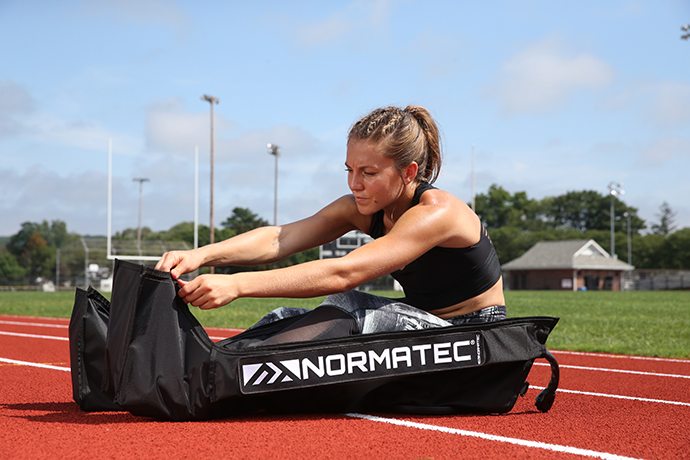How Athletes Use Compression to Make Recovery the Focus of Their Training
We’ve long praised the benefits of compression sleeves for running and recovery (in fact, I wore them frequently during my hike up Mount Kilimanjaro). Long story short, compression socks improve your circulation simply by the virtue of being so tight, they literally squeeze your muscles and allow blood to flow through the muscles faster. With the help of compression, you can recover faster from tougher workouts, so a weight-lifting session that would have previously left you sidelined for a couple of days no longer ruins your ability to walk up stairs normally for the rest of the week.

But what if you want to take that recovery up a notch, while also looking like an uber-fashionable astronaut? If that sounds like you, you might be looking for some compression boots.
Compression boots from brands like NormaTec and Recovery Pump are becoming prevalent in more and more studios and recovery lounges across the country, as recovery continues to be a major trend for 2018 and beyond.
EDGE Athlete Lounge owner Robyn LaLonde realized the power of compression boots almost by accident while training for her first 100K.
“You assume you’ll feel like garbage all the time, right?” LaLonde laughed. “But we kept entering marathons and using them as training runs — and we kept PRing! It was really weird. We realized that we had been using the compression boots as recovery tools at our house just to see if they’d help us feel less garbage-y.”
Those PRs led to major revelations as LaLonde and husband were planning the opening of EDGE.
“We were like…wait a second, this is not supposed to be in the corner of your business. It should be the center of the experience.”
According to NormaTec representative Breck Rice, using compression boots after an especially tough workout is a smart way to fasttrack your recovery.
“Using the NormaTec Recovery System before or after intense exercise promotes enhanced circulation and rejuvenates sore muscles,” Rice explains. “Studies have also shown a wider range of benefits, such as flushing out metabolic waste like lactate, and increasing range of motion. It’s like a personal, on-call massage therapist, and it uses patented technology to help athletes recover faster.”
Here’s how it works:
After donning the compression boots and elevating your legs, a sophisticated pulse system systematically and dynamically compresses your feet, gradually moving its way up your legs to squeeze and massage your muscles. Instead of a static compression (like a sleeve), the system pulses for a more dynamic compression, further enhancing the movement of fluid through your muscles.
Because using the recovery boots is a form of active recovery (rather than passively taking the day off), you’re able to bounce back into your training feeling refreshed and ache-free — and that just might be the difference-maker when it comes to reaching your fitness goals.
“Many athletes tell us that their true gains are achieved in between training, during recovery time, when the body adapts to the training and becomes stronger, faster,” shares Rice. “Coaches also report that a player’s ability to perform is their greatest asset, so being able to effectively recover in between training means less days lost, and more consistent performance at a player’s highest ability.”
How it’s becoming central to athletes’ training regimens:
Through the rise of group conditioning classes and strength training programs, more fitness fans are buying into the notion of “training like an athlete.” However, with serious work comes the need for serious recovery, whether you’re a professional athlete or a stay-at-home mom who does CrossFit.
The LaLondes used this guiding principle to build EDGE — so much so that Robyn realizes they rarely talk about recovery on its own anyone; it’s just what athletes have come to expect as part of the package deal when training with EDGE.
As LaLonde notes, “We really think the everyday athlete should be elevated to whatever their potential is — but it’s hard to do when you work full-time, or have families and responsibilities. We can give [our athletes] an advantage in their recovery game by [using compression boots for] hitting reset faster, clearing waste byproducts and extra fluids out of their muscles and back into their core so they can get more out of their workouts.
“The byproduct,” she states matter-of-factly, “is you feel less crappy.”
Rice agrees that recovery is becoming more and more accessible and necessary for everyday athletes, adding that “Recovery is definitely a big movement in athletics right now. This is probably because it really works!
“We think that the recovery trend is not just a trend, but a movement that is backed by science and by actual athlete success. Recovery will continue to grow and to infuse the athlete lifestyle. More amateur athletes will place an emphasis on their active recovery techniques, and even more mainstream training facilities will add recovery services for their clientele.”












